With policy support, the localization rate of automotive MCU will surge.
Chinese electric vehicle companies are quickening their pace of purchasing domestic chips to reduce their dependence on imported ones and expedite the development of China's semiconductor industry system. According to unofficial goals, the overall penetration rate of homegrown automotive chips will be increased to over 20% in 2025, and state-owned and private automakers are encouraged to buy homemade chips as priority. Amid the long mass production cycle of automotive MCUs and the extremely low localization rate for a long time, the policy support will help local automotive MCUs boom.??
In January 2024, the Ministry of Industry and Information Technology released the Guidelines for the Construction of the National Automotive Chip Standard System, suggesting that: in 2025, more than 30 key automotive chip standards should be formulated to clarify the basic requirements concerning environment and reliability, electromagnetic compatibility, functional safety, information security and more, and the technical specifications for key products and applications including control, computing, storage, power and communication chips should be formulated to meet the basic needs for safe and reliable application and pilot demonstration of automotive chip products; in 2030, more than 70 automotive chip standards should be formulated. Favorable policies facilitate the development of Chinese automotive MCU vendors.?
International giants gain first-mover advantages in automotive MCUs. Chinese vendors started with body control with relatively low safety requirements, and some leading companies also work to make layout in power/chassis, cockpit, and autonomous driving fields. Chinese vendors gradually improve their automotive MCU product line layout and narrow the gap with international tycoons in product performance.?
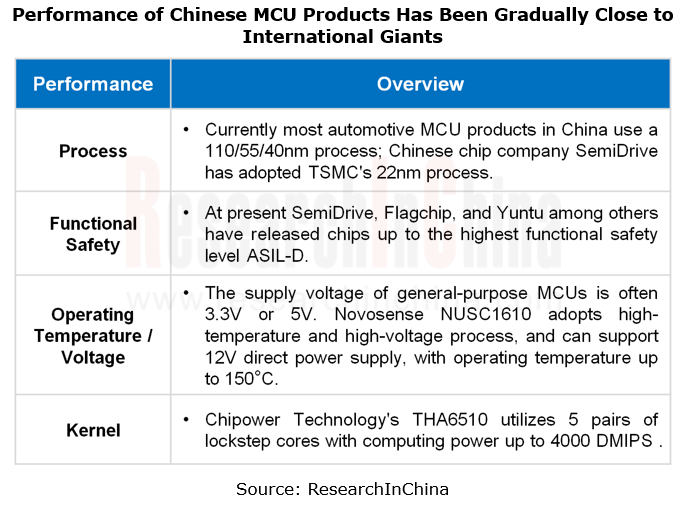
1. Chinese automotive MCU vendors have made an all-round layout of low-, mid- and high-end products.
High-end automotive MCUs have always been monopolized by international giants. For example, Infineon has a monopoly in the autonomous driving field; NXP and Renesas prevail in the gateway and power/chassis fields.???
In recent years, Chinese vendors have been vigorously laying out high-end automotive MCU products, and some of them such as SemiDrive, AutoChips have already made a foray into the high-end market.
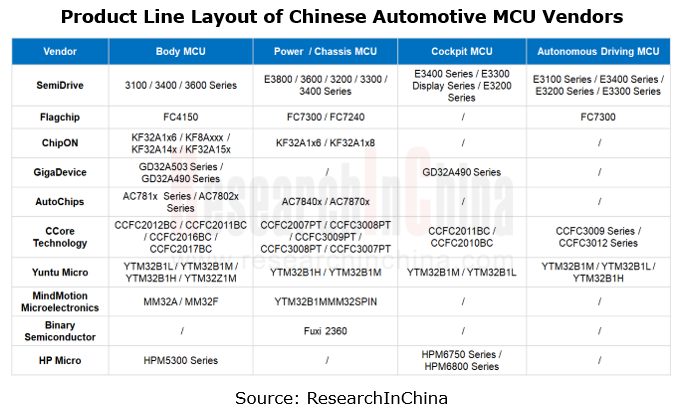
SemiDrive: it launched the E3 series of automotive MCUs for domain control, body, chassis, power, ADAS, battery management system (BMS) and other applications in 2022, and has shipped more than a million pieces. Suspension controllers (CDC) mounted on models like Chery Tiggo 9 and EXEED Stellar are powered by SemiDrive E3 series products.????
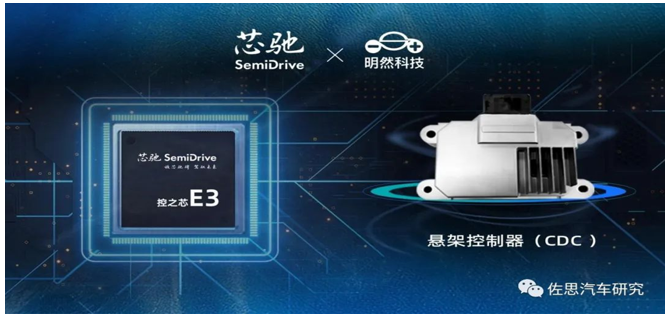
In March 2024, SemiDrive further improved the E3 series and released E3119F8/E3118F4, targeting such application fields as body domain control, zone controllers, front-view all-in-one, and LiDAR. The new product uses ARM Cortex R5F CPU, and packs at most two independent 400MHz high-performance application kernels, with the main frequency of the information security kernel up to 200MHz. In terms of tool chain, SemiDrive supports IAR and Greenhills, adapts to the mainstream ARM debugger, and provides SDK/MCAL basic software support. Currently, SemiDrive is partnering with multiple Chinese and foreign AutoSAR vendors and working on BSW adaptation.?????
In current stage, SemiDrive's products have covered high-end fields of zone control, chassis and intelligent driving.??
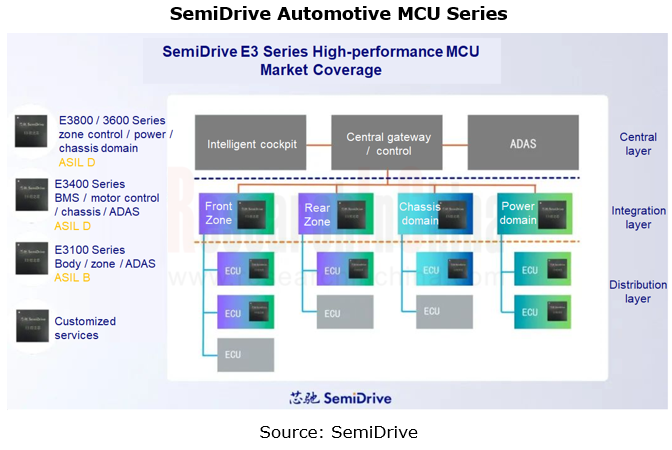
AutoChips: In October 2023, it introduced AC7870x, its first multi-kernel high-frequency MCU that meets the ASIL-D functional safety level and is based on Arm Cortex R52 kernel. AC7870x is primarily applied in the fields of power chassis, “three electrics” for new energy vehicles, and zone controllers under new EEA. The company thus officially entered the high-end automotive MCU field.???????
2. Build an independent domestic chip supply chain.
From 2021 to 2022, automotive MCUs were difficult to buy, with soaring prices, which made Chinese automakers realize the importance of an independent supply chain system and also gave scope to China’s local automotive MCUs.???
Chinese MCU vendors are trying hard to build a local supply chain:
Yuntu Micro: More than half of upstream partners are domestic. The company has achieved full localization in multiple links from upstream wafer fabs to packaging and testing. The localized supply chain makes products more cost-effective.??
OmniVision: OMX14xN in the OMX14x series is an automotive MCU with a fully localized supply chain from fab to packaging and testing.
AutoChips: AC7802x, an automotive MCU mass-produced in August 2023, is a fully localized chip.?
Application of automotive MCU in functional domains
Conventional automobiles need about 40-50 MCUs. As EEA gets upgraded, the MCU requirements of autonomous driving, cockpit, body & zone control, power, chassis, central computing and so on have also changed. MCU products head in the direction of high performance.??
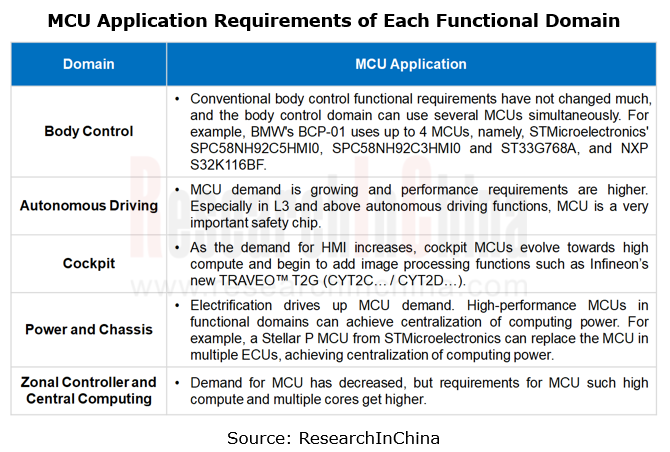
For autonomous driving domain control, mainstream MCU products include Infineon TC297X/397X Series and the latest TC4X Series, ST Stellar Series, Renesas RH850 Series, TI Hercules, and SemiDrive E3 Series.??
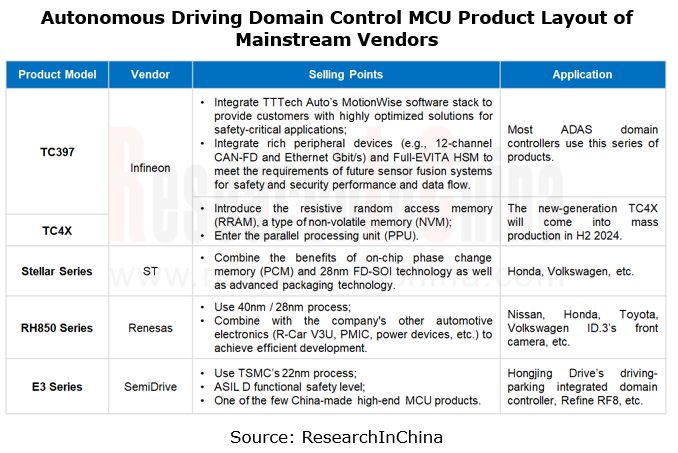
Central supercomputing platforms have higher requirements on chips' functional safety. For example, Leapmotor's Four Leaf Clover central supercomputing platform adopts NXP S32G. Wherein, the Standard Configuration version adopts Qualcomm 8155 (3rd Generation Snapdragon Cockpit Platform) + NXP S32G (3 cores); the Medium Configuration version adopts Qualcomm 8295 (4th Generation Snapdragon Cockpit Platform) + NXP S32G (7 cores).???
NXP S32G Family utilizes three 400MHz Arm Cortex-M7 cores, and provides support for different products according to cost requirements and application scenarios.??
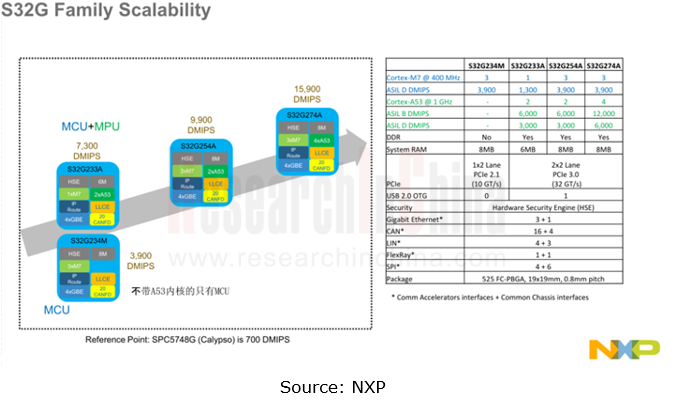 ?
?
MCU core design trends include GPU, new storages, built-in HSM security components, etc.
Conventional MCU products mainly integrate eight components such as CPU, memory, I/O port, serial port, timer, interrupt system and special function register. The development of domain control architecture brings new demand for high-performance and high-security MCUs.
Furthermore with the increasingly high MCU performance, the difference between MCU and MPU becomes ever smaller. From some moves of international giants in current stage, it can be seen that crossover MCU or crossover MPU is a layout direction they head in. Putting some hardware only available in MPU into MCU not only realizes low power consumption, low cost and simplicity of MCU, but also enables applications that were enabled only by MPU in the past.?????
MCU’s graphics processing capabilities are being enhanced.
As vehicles pose ever higher requirements for image definition, zoomable maps, video play, etc., MCU vendors have begun to compete in graphics processing in recent year. International tycoons like ST, Infineon, Renesas and NXP have launched MCU products with GPU integrated. Chinese vendors such as GigaDevice and HPMicro have also been working to make layout.???
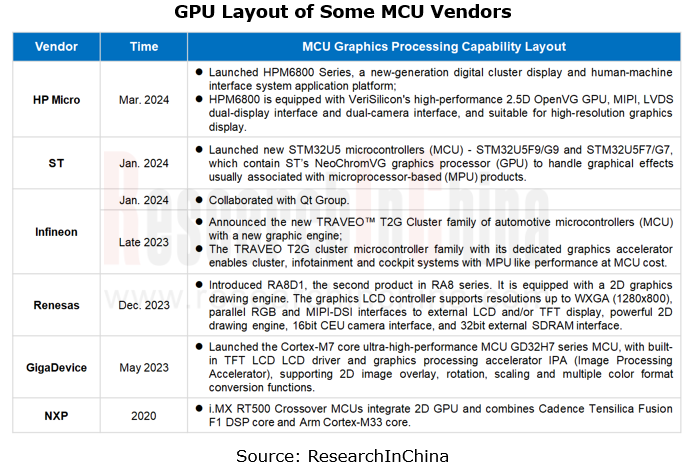 ?
?
For example, the new TRAVEO? T2G Cluster family of automotive microcontrollers (MCU) with a new graphics engine enables cluster, infotainment and cockpit systems with MPU like performance at MCU cost.??
In terms of memory, the graphics engine within the MCUs minimizes the memory required for graphics processing by a factor of 3 to 5, resulting in lower power consumption and lower costs.
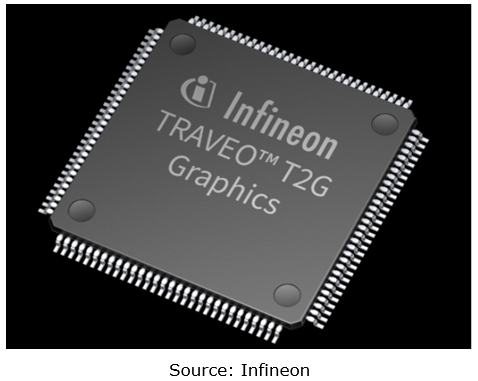
The requirements for MCU security are higher.
MCU is an important node in vehicle networks and interacts with other ECUs (electronic control unit) via communication protocols such as CAN (controller area network) bus or Ethernet. These communication protocols, if not encrypted or authenticated, will easily intercepted and tampered by attackers, leading to malicious vehicle control or other safety incidents.
MCU thus plays a critical role in automotive cybersecurity. To cope with increasingly severe cybersecurity threats, effective measures need to be taken to strengthen automotive cybersecurity. Major automotive MCU vendors are also vigorously deploying high-security MCU products.?
SemiDrive: SemiDrive E3 series meets the AEC-Q100 Grade 1 reliability certification. It is China’s first MCU to pass German TUV ASIL D/SIL 3 functional safety level certification and China’s national cryptographic product Level 2 certification, and has passed the TUV ASPICE CL2 evaluation. It is known that the new automotive MCU products E3119F8 and E3118F4 unveiled in March 2024 integrate hardware security modules (HSM), comply with the Full EVITA information security level, and cooperate with the industry's leading information security solution providers, and support ISO 21434-compliant information security firmware. This sub-series can support ISO 26262 ASIL-B functional safety level. SemiDrive will provide functional safety software library, FMEDA and various functional safety documents, and complete the ASIL-B level product functional safety certification.????
Renesas: The RH850 series MCUs have a built-in intelligent cryptography unit (ICU), which stores the secret key in a separate storage area that cannot be directly accessed by the CPU. A dedicated mechanism is required to enhance the actual anti-tampering function and support high-end encryption operations such as RSA and ECC. They can provide security services such as software operation prevention, hardware and software connection, secure boot, and verification of ECUs in network nodes.
Automotive Microcontroller Unit (MCU) Industry Report, 2024 released by ResearchInChina highlights the following:
 Automotive MCU market (status quo, size, pattern, supply and demand, etc.;)
Automotive MCU market (status quo, size, pattern, supply and demand, etc.;)
 Application, localization and main product cases of automotive MCU in different application fields (body control, autonomous driving, intelligent cockpit, power chassis, central computing domain control, etc.);
Application, localization and main product cases of automotive MCU in different application fields (body control, autonomous driving, intelligent cockpit, power chassis, central computing domain control, etc.);
 Key points in automotive MCU industry development (process, core technology, storage technology, image processing function, functional safety, etc.);
Key points in automotive MCU industry development (process, core technology, storage technology, image processing function, functional safety, etc.);
 Chinese and foreign automotive MCU vendors (product layout, new product R&D dynamics, product applications, etc.).?
Chinese and foreign automotive MCU vendors (product layout, new product R&D dynamics, product applications, etc.).?
?
48V Low-voltage Power Distribution Network (PDN) Architecture and Supply Chain Panorama Research Report, 2025
For a long time, the 48V low-voltage PDN architecture has been dominated by 48V mild hybrids. The electrical topology of 48V mild hybrids is relatively outdated, and Chinese OEMs have not given it suf...
Research Report on Overseas Cockpit Configuration and Supply Chain of Key Models, 2025
Overseas Cockpit Research: Tariffs stir up the global automotive market, and intelligent cockpits promote automobile exports
ResearchInChina has released the Research Report on Overseas Cockpit Co...
Automotive Display, Center Console and Cluster Industry Report, 2025
In addition to cockpit interaction, automotive display is another important carrier of the intelligent cockpit. In recent years, the intelligence level of cockpits has continued to improve, and automo...
Vehicle Functional Safety and Safety Of The Intended Functionality (SOTIF) Research Report, 2025
Functional safety research: under the "equal rights for intelligent driving", safety of the intended functionality (SOTIF) design is crucial
As Chinese new energy vehicle manufacturers propose "Equal...
Chinese OEMs’ AI-Defined Vehicle Strategy Research Report, 2025
AI-Defined Vehicle Report: How AI Reshapes Vehicle Intelligence?
Chinese OEMs’ AI-Defined Vehicle Strategy Research Report, 2025, released by ResearchInChina, studies, analyzes, and summarizes the c...
Automotive Digital Key (UWB, NearLink, and BLE 6.0) Industry Trend Report, 2025
Digital key research: which will dominate digital keys, growing UWB, emerging NearLink or promising Bluetooth 6.0?ResearchInChina has analyzed and predicted the digital key market, communication techn...
Integrated Battery (CTP, CTB, CTC, and CTV) and Battery Innovation Technology Report, 2025
Power battery research: 17 vehicle models use integrated batteries, and 34 battery innovation technologies are released
ResearchInChina released Integrated Battery (CTP, CTB, CTC, and CTV)and Battery...
AI/AR Glasses Industry Research Report, 2025
ResearchInChina released the " AI/AR Glasses Industry Research Report, 2025", which deeply explores the field of AI smart glasses, sorts out product R&D and ecological layout of leading domestic a...
Global and China Passenger Car T-Box Market Report 2025
T-Box Research: T-Box will achieve functional upgrades given the demand from CVIS and end-to-end autonomous driving
ResearchInChina released the "Global and China Passenger Car T-Box Market Report 20...
Automotive Microcontroller Unit (MCU) Industry Report, 2025
Research on automotive MCUs: the independent, controllable supply chain for automotive MCUs is rapidly maturing
Mid-to-high-end MCUs for intelligent vehicle control are a key focus of domestic produc...
Automotive LiDAR Industry Report, 2024-2025
In early 2025, BYD's "Eye of God" Intelligent Driving and Changan Automobile's Tianshu Intelligent Driving sparked a wave of mass intelligent driving, making the democratization of intelligent driving...
Software-Defined Vehicles in 2025: SOA and Middleware Industry Research Report
Research on automotive SOA and middleware: Development towards global SOA, cross-domain communication middleware, AI middleware, etc.
With the implementation of centrally integrated EEAs, OEM softwar...
Global and Chinese OEMs’ Modular and Common Technology Platform Research Report, 2025
Modular platforms and common technology platforms of OEMs are at the core of current technological innovation in automotive industry, aiming to enhance R&D efficiency, reduce costs, and accelerate...
Research Report on the Application of AI in Automotive Cockpits, 2025
Cockpit AI Application Research: From "Usable" to "User-Friendly," from "Deep Interaction" to "Self-Evolution"
From the early 2000s, when voice recognition and facial monitoring functions were first ...
Analysis on Li Auto’s Layout in Electrification, Connectivity, Intelligence and Sharing, 2024-2025
Mind GPT: The "super brain" of automotive AI Li Xiang regards Mind GPT as the core of Li Auto’s AI strategy. As of January 2025, Mind GPT had undergone multip...
Automotive High-precision Positioning Research Report, 2025
High-precision positioning research: IMU develops towards "domain controller integration" and "software/hardware integrated service integration"
According to ResearchInChina, in 2024, the penetration...
China Passenger Car Digital Chassis Research Report, 2025
Digital chassis research: Local OEMs accelerate chassis digitization and AI
1. What is the “digital chassis”?
Previously, we mostly talked about concepts such as traditional chassis, ch...
Automotive Micromotor and Motion Mechanism Industry Report, 2025
Automotive Micromotor and Motion Mechanism Research: More automotive micromotors and motion mechanisms are used in a single vehicle, especially in cockpits, autonomous driving and other scenarios.
Au...